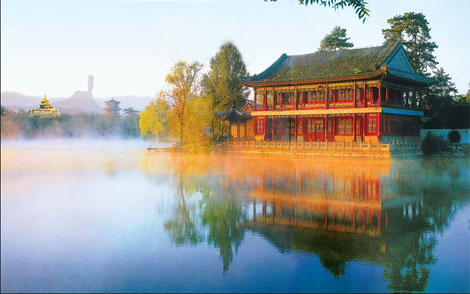|
 |
| Chengde Mountain Resort in Hebei province. |
Hundreds of years ago emperors of the Qing Dynasty (1644-1911) often stayed in the city of Chengde not far from Beijing in summer or when they traveled to northeast China. Chengde has since been famous for its charming scenery, historic sites and pleasant weather.
Tourists to Chengde can climb the Great Wall at Jinshanling and recall the glory and hardship of ancient warriors, enjoy horse rides at the Mulan royal hunting ground - the world's largest imperial hunting ground - or wander through the imperial gardens at Chengde Mountain Resort and absorb ancient wisdom at its outlying temples.
Chengde's appeal also lies in its diverse ethnic culture. Here you may join the singing and dancing of Manchu and Mongolian people, listen to the Buddhist understanding of the world, taste a range of Manchu-Han dishes, try snacks unique to the region, enjoy the folk arts of cloth painting and paper cutting, or savor local produce such as hazelnuts and mushrooms.
Among more than 50 tourist sites in Chengde, 23 have been rated Grade A at the national level. It has four four-star, 12 three-star and 14 two-star hotels along with more than 2,000 restaurants, dozens of karaoke and dance halls and a bowling alley. The city has 2,300 tour guides, a number of whom speak English, Japanese, German, French, Italian and Korean.
Major attractions
Chengde's Mountain Resort was an important part of imperial life during the Qing Dynasty. Built over 89 years during the most prosperous decades of the dynasty, the resort combines 72 scenic sites and is the world's largest classic imperial garden. It is composed of a palace area, greens, lakes and hills. It has amassed both the delicate plants of southern gardens and the grandeur of north China's parks, thus "collecting all beautiful scenes under the sky in one garden".
Outlying Temples
The Eight Outlying Temples surrounding the Mountain Resort of Chengde are the largest group of imperial monasteries in the world.
The temple of the Potaraka Doctrine - Putuozongsheng Miao - was modeled on the Potala palace in Lhasa, Temple of Far-spreading Peace - Anyuan Miao - after Gurza Temple in the Xinjiang Uygur autonomous region, Puning Temple after a monastery in Tibet, Pule Temple after the Temple of Heaven in Beijing, and Shuxiang Temple an exact copy of the original Shuxiang Temple on Mount Wutai in Shanxi province. The temples not only represent the magnificence of Mongolian, Tibetan, Uygur, Han and Manchurian groups, but also the unity of people of different cultures and origins.
Jinshanling Great Wall
The Jinshanling part of the Great Wall is among the most representative. Inside Chengde, the section of wall was first built in 1368, the year the Ming Dynasty was established, under the supervision of top general Xu Da. It is a national key historic site, a State-level scenic spot and a listed site for World Heritage.
The 10.5 km section starts from Longling Pass in the west and ends at Wangjinglou Tower in the east. Along the stretch are 67 battlements and five passes. It is the most well preserved section of the Ming Dynasty Great Wall and considered the highest form of the Ming wall due to its intricate defense systems.
Jingbei No 1 Prairie
Jingbei No 1 Prairie, also named Datan Prairie, received its name because it is the closest natural grassland to Beijing. It spans 285 km from south to north and covers 350 sq km. Its clear lakes, shoulder-high grass and grazing sheep make its sound ecosystem famous from ancient times.
The region is 1,487 m in altitude with waves of grass filled with colorful flowers, singing birds and running horses. In addition to horseback riding, visitors can ride camels, join in archery and hunting or fly a kite.
The grasslands are home to mostly Manchurian and Mongolian people who may invite you to join them.
 |
|
Jinshanling section of the Great Wall in Hebei province.
|
|